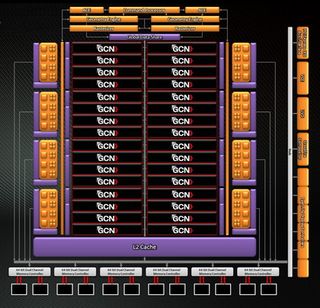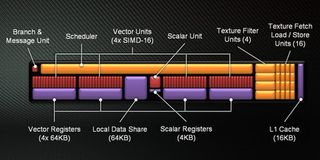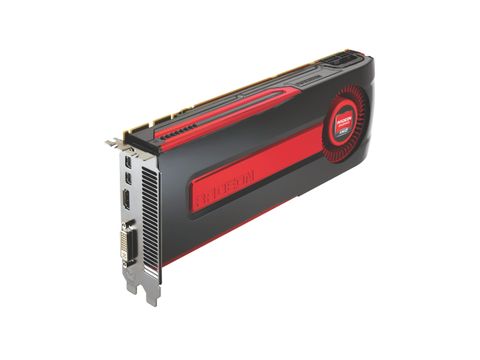Why you can trust TechRadar
In terms of the actual make up of the AMD Radeon HD 7970 it's a fairly different beast to the previous, Cayman GPU-powered AMD Radeon HD 6970.
This card represents a new direction in GPU tech for AMD as well as a brand new production process and GPU technologies.
In terms of firsts AMD has them all pretty much nailed with the Radeon HD 7970. It's the first GPU to be built with miniscule 28nm transistors, the first DirectX 11.1 graphics card and the first official PCI Express 3.0 component too.
Of all those the really interesting one is the 28nm die shrink that comes with this new Tahiti core. The Tahiti GPU is going to be the chip powering the top end cards and that in turn is built on the new Graphics Core Next architecture.

The whole HD 7000 series also goes by the name of Southern Islands, hence the Tahiti tag.
That die-shrink means that it can jam more components into a smaller chip footprint and that should mean more power to you.
And compared to the number of 40nm transistors in the AMD Radeon HD 6970, a paltry 2.6 billion, it has done a good job of squeezing more into the Radeon HD 7970.
This card has 4.3 billion transistors in the GPU itself.
That there is a frightening number, and AMD has a lot more of those up its sleeve for the Radeon HD 7970.
AMD's claimed compute performance for the Tahiti XT GPU inside the HD 7970 is one such number. At 3.79 TFLOPs there is some impressive number crunching capabilities buried inside this chip.
All it needs is the software to take advantage of it.
The compute performance has been the driving factor in the change from Northern Islands to Southern Islands, and from the traditional vector style processor to the scalar processor that makes up this new GPU.
Previously AMD had focused most of its silicon towards the goal of making a card specifically for graphical processing, leaving the more ephemeral notion of general purpose GPU computing to Nvidia and its CUDA cores.
So it put all its eggs in the four-way vector processor architecture basket. Essentially that meant sorting out single instructions into batches before firing them down the GPU pipelines. It was a much more elegant solution and for doing fixed graphical processing it was incredibly efficient.
The resulting HD 4xxx thru HD 6xxx series cards were great pixel pushers at impressively lower power requirements than their peers.
Now though AMD wants a slice of the GPGPU pie and as such has shifted to a similar scalar architecture to that used by long-time rivals Nvidia.

That means it's going for a more brute force approach which involves having a large number of simple processors in an array, giving them each one thing to work on at a time until all the instructions have been completed.
The Graphics Core Next architecture then is built of Compute Units, which are similar in nature to teh Streaming Microprocessors Nvidia introduced with the Fermi architecture.
The Tahiti XT GPU in the Radeon HD 7970 is built up of 32 of these Compute Unites which are essentially self-contained processors capable of acting independently of the whole.
Inside each of the Compute Units are four vector units, and in each of those is 16 unified shaders or stream processors or Radeon Cores. Depending on who you talk to.
That means in the full Tahiti XT you'll find 2,048 shaders, and compared to the 1,536 shaders of the HD 6970 that's a fair mark up.
It's this combination of the four-way vector processing and the scalar architecture that AMD hopes will push its Tahiti-based GPUs to the top of the graphics card pile.
Though it's not just the number of Compute Units that makes the difference in performance terms, the actual core clock of the Radeon HD 7970 is far higher than previous cards too.
At 925MHz out of the box it's a chunk faster than the 880MHz of the Radeon HD 6970.
So, what do all these new architectural shenanigans mean for the graphics card's performance then? Let's find out…

